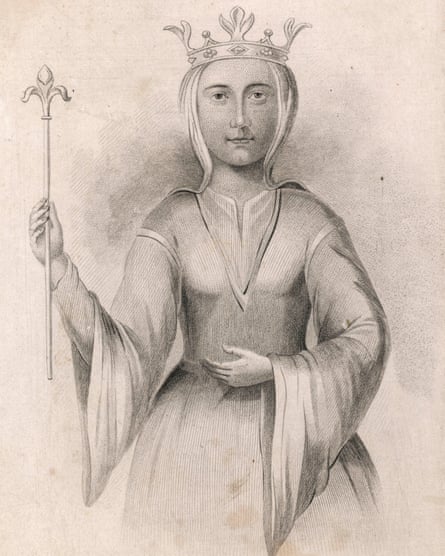England’s first civil war raged for almost 20 years – and outdid Game of Thrones for violence and treachery. Indeed, the 12th-century conflict was so intense it changed the landscape of the nation for decades, according to newly published archaeological research.
Fortified villages and churches appeared across the country. Rivals to the king’s mints made coins in different territories. And a network of castles – to hold back rebels – was constructed.
“Most people would think of ‘medieval warfare’ in terms of large-scale pitched battles, but our study shows the conflict was instead characterised by devastation of the landscape and by siege warfare,” said Professor Oliver Creighton, of Exeter University, leader of the research project. “These sieges often resembled a prolonged standoff between the two sides, rather than close combat. Some have left traces in the landscape that we can see even though more than 800 years have passed.”
The violence of the time and its impact on the landscape is also bleakly suggestive of George RR Martin’s books, which HBO turned into the hit TV series Game of Thrones. However, the fictional series and England’s first civil war – known to some historians as the Anarchy – have even closer parallels, it transpires.
The war erupted after the death of King Henry I, the son of William the Conqueror, on 1 December 1135. Henry’s daughter Matilda claimed the throne – but her cousin, Stephen of Blois, reacted first and had himself crowned king of England at Westminster Abbey on 22 December. In response, Matilda launched a campaign, supported by her half-brother, Robert of Gloucester, and her uncle, King David I of Scotland, to win back the throne.
Within a short time, the English countryside had been militarised as the two sides and their allies fought battles that ranged across England. Churches were fortified – Hereford cathedral even had catapults placed on its tower. Landowners buried hoards of coins to save them from looters, while many areas of the country were laid waste.

The Isle of Ely in Cambridgeshire was transformed into a desert, according to contemporary chroniclers, while Wallingford, on the Thames, became one of the most besieged places in the nation. During the 19-year war, its inhabitants were forced to fight off three sieges.
“The conflict ravaged the landscape. It was a time of violent upheaval. It was a vicious, prolonged war,” said Creighton, whose book of his team’s archaeological research, The Anarchy: War and Status in 12th-Century Landscapes of Conflict – co-written with Duncan Wright, also of Exeter University – has just been published by Liverpool University Press.
If that sounds familiar to Game of Thrones fans, it should. The conflict that enveloped England looks very close to the battles that engulfed Westeros and Essos in the TV series. For good measure, one of the latter’s key plot lines closely mirrors the origins of the Anarchy. Matilda was the king’s daughter but was not accepted by some nobles, because she was a woman, and her throne was subsequently usurped by her male cousin. So Matilda fought to get it back.
Likewise, in Game of Thrones, Yara Greyjoy – daughter of King Balon Greyjoy claims the Salt Throne of the Iron Islands when her father dies. However, as a woman she is deemed unacceptable to some and the throne is seized, in this case by her uncle, Euron. Yara then launches her campaign to get back the throne through various alliances with others key characters in the series. (At the end of the most recent episode of Game of Thrones, which was screened last year, Yara’s bid to gain the crown of the Iron Islands remains unresolved.)

In fact, George RR Martin has hinted that medieval England may have been very much on his mind when he was writing his epic fantasy novels. In another key episode of Game of Thrones, young King Joffrey Baratheon, lord of the seven kingdoms, dies after choking at a feast. (In fact, he has been poisoned.) But as several fan websites have pointed out, this incident mirrors events during Stephen’s troubled reign. In 1153, the king’s only son Eustace died – and it is said this occurred at a feast, and possibly from choking or poisoning. Crucially, his death led to the resolution of the conflict. An agreement was reached with the grieving Stephen that he could remain as king, but that Matilda’s son Henry would inherit the throne when he died.
At this point, the story of the Anarchy diverges sharply from the carnage depicted in Game of Thrones. When Henry inherited the throne in 1154, he began a process of demilitarising the countryside, rebuilding the machinery of government and knocking down the castles that had been built across the nation during Stephen’s reign. Peace was restored – an unlikely outcome for Game of Thrones, whenever its final episode is written and filmed.
Civil war’s impact on the landscape of England during the Anarchy is nevertheless intriguing and has been uncovered through extensive efforts by Creighton and his colleagues. Remains at a range of carefully selected sites, including castles and settlements, were studied while existing archaeological finds, including coins and weaponry, were re-analysed. In addition, state-of-the-art survey techniques were used alongside the examination of historic maps and documents.
“We wanted to open up new perspectives on this darkly fascinating period by interpreting the material evidence – artefacts, sites and landscapes – as well as studying documents,” said Creighton.
“Our research shows that for the aristocracy this was a period of image-making, as well as warmongering, when amid the turmoil lords stamped their mark on the English landscape.”
Additional research by Sarah Mitchell

Comments (…)
Sign in or create your Guardian account to join the discussion